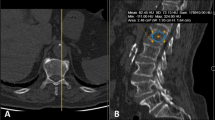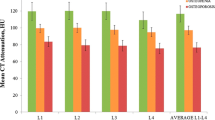Abstract
Objectives
Opportunistic screening for osteoporosis using computed tomography (CT) examinations that happen to visualise the spine can be used to identify patients with osteoporosis. We sought to verify the diagnostic performance of vertebral Hounsfield unit (HU) measurements on routine CT examinations for diagnosing osteoporosis in a separate, external population.
Methods
Consecutive patients who underwent a CT examination of the chest or abdomen and had also received a dual-energy X-ray absorptiometry (DXA) test were retrospectively included. CTs were evaluated for vertebral fractures and vertebral attenuation (density) values were measured. Diagnostic performance measures and the area under the receiver operator characteristics curve (AUC) for diagnosing osteoporosis were calculated.
Results
Three hundred and two patients with a mean age of 57.9 years were included, of which 82 (27 %) had osteoporosis according to DXA and 65 (22 %) had vertebral fractures. The diagnostic performance for vertebral HU measurements was modest, with a maximal AUC of 0.74 (0.68 – 0.80). At that optimal threshold the sensitivity was 62 % (51 – 72 %) and the specificity was 79 % (74 – 84 %).
Conclusions
We confirmed that simple trabecular vertebral density measurements on routine CT contain diagnostic information related to bone mineral density as measured by DXA, albeit with substantially lower diagnostic accuracy than previously reported.
Key Points
• We externally validated the value of vertebral trabecular bone attenuation for osteoporosis
• These diagnostic performance measures were, however, substantially lower than previously reported
• This information might be useful when considering the implementation of opportunistic osteoporosis screening



Similar content being viewed by others
References
Pickhardt PJ, Pooler BD, Lauder T et al (2013) Opportunistic screening for osteoporosis using abdominal computed tomography scans obtained for other indications. Ann Intern Med 158:588–595
Bessette L, Ste-Marie L-G, Jean S et al (2008) The care gap in diagnosis and treatment of women with a fragility fracture. Osteoporos Int J Establ Result Coop Eur Found Osteoporos Natl Osteoporos Found USA 19:79–86
Metge CJ, Leslie WD, Manness L-J et al (2008) Postfracture care for older women: gaps between optimal care and actual care. Can Fam Physician Méd Fam Can 54:1270–1276
King AB, Fiorentino DM (2011) Medicare payment cuts for osteoporosis testing reduced use despite tests’ benefit in reducing fractures. Health Aff Proj Hope 30:2362–2370
Leslie WD, Giangregorio LM, Yogendran M et al (2012) A population-based analysis of the post-fracture care gap 1996-2008: the situation is not improving. Osteoporos Int J Establ Result Coop Eur Found Osteoporos Natl Osteoporos Found USA 23:1623–1629
Riggs BL, Melton LJ, Robb RA et al (2007) A population-based assessment of rates of bone loss at multiple skeletal sites: evidence for substantial trabecular bone loss in young adult women and men. J Bone Miner Res 23:205–214
Buckens CF, de Jong PA, Mol C et al (2013) Intra and interobserver reliability and agreement of semiquantitative vertebral fracture assessment on chest computed tomography. PLoS ONE 8:e71204
Buckens C, de Jong P, Mali W et al (2013) Prevalent vertebral fractures on chest CT: higher risk for future hip fracture. J Bone Miner Res Off J Am Soc Bone Miner Res. doi:10.1002/jbmr.2028
Raisz LG (2005) Clinical practice. Screening for osteoporosis. N Engl J Med 353:164–171
The National Osteoporosis Foundation (NOF) (2013) Clinician’s guide to prevention and treatment of osteoporosis. The National Osteoporosis Foundation, Washington, DC
Majumdar SR, Leslie WD (2013) Conventional computed tomography imaging and bone mineral density: opportunistic screening or “incidentaloporosis”? Ann Intern Med 158:630–631
Altman DG, Royston P (2000) What do we mean by validating a prognostic model? Stat Med 19:453–473
Genant HK, Wu CY, van Kuijk C, Nevitt MC (1993) Vertebral fracture assessment using a semiquantitative technique. J Bone Miner Res Off J Am Soc Bone Miner Res 8:1137–1148
Oei L, Rivadeneira F, Ly F et al (2013) Review of radiological scoring methods of osteoporotic vertebral fractures for clinical and research settings. Eur Radiol 23:476–486
Gruber M, Bauer JS, Dobritz M et al (2013) Bone mineral density measurements of the proximal femur from routine contrast-enhanced MDCT data sets correlate with dual-energy X-ray absorptiometry. Eur Radiol 23:505–512
Acknowledgments
The scientific guarantor of this publication is Pim De Jong. The authors of this manuscript declare no relationships with any companies, whose products or services may be related to the subject matter of the article. This study has received funding by the Netherlands Organization for Scientific Research-Medical Sciences (NWO-MW) grant 40-00812-98-07-005. One of the authors has significant statistical expertise. Institutional review board approval was not required due to previous blanket approval of anonymous retrospective studies on retained diagnostic information that does not impact patient care.
Written informed consent was waived by the institutional review board. Methodology: retrospective, observational, performed at one institution.
Author information
Authors and Affiliations
Corresponding author
Electronic supplementary material
Below is the link to the electronic supplementary material.
Figure 4
Receiver operating characteristics curve for vertebral bone density model predicting DXA-assigned osteoporosis for women (dashed grey line) and men (solid black line) separately, with the area under the cure (AUC) for each printed in the legend. (PDF 5 kb)
Table 3
(DOC 37 kb)
Table 4
(DOC 60 kb)
Rights and permissions
About this article
Cite this article
Buckens, C.F., Dijkhuis, G., de Keizer, B. et al. Opportunistic screening for osteoporosis on routine computed tomography? An external validation study. Eur Radiol 25, 2074–2079 (2015). https://doi.org/10.1007/s00330-014-3584-0
Received:
Revised:
Accepted:
Published:
Issue Date:
DOI: https://doi.org/10.1007/s00330-014-3584-0




